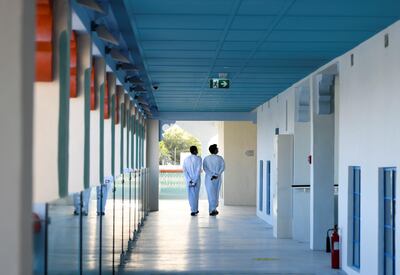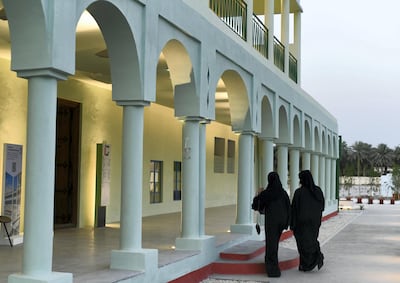The newly restored Bait Mohammed bin Khalifa is a patchwork of Al Ain’s past, present and future.
The old room of Sheikh Mohammed bin Khalifa bin Zayed Al Nahyan is a portal to the UAE of the late 1960s. A box-shape air-conditioning unit blares as it blasts out cold air. An old transistor radio cackles a song by Umm Kulthum. There are Arabic newspapers lying on the floor seating, with headlines that read of unification plans of the seven emirates.
But as you go from room to room, moving from state-of-the-art classrooms to majlis fitted with touchscreens, you'll find yourself swept away by an anachronistic charm.
You’ll move from spaces fitted with computers to a room that features a large chrysalis-shaped installation that shows how Al Ain will look a decade from now.
When Bait Mohammed bin Khalifa was built in 1958, it functioned as more than simply a home for Mohammed bin Khalifa and his family.
The historic building was the heart of Al Ain’s community gatherings. Many of the country’s leading figures – including Sheikh Zayed, the Founding Father and son-in-law to Mohammed bin Khalifa – met at the majlis in the house. There, they discussed ongoing developments as the country moved into its post-oil era and exchanged ideas about what the future of the UAE would look like.
The building, located in the Unesco World Heritage area, stood at the entrance of Al Ain and remained one of the emirate’s most treasured landmarks long after the Al Nahyan family moved out.
Bait Mohammed bin Khalifa reopened as a cultural centre last month, and it took more than a fresh coat of paint to reinstate the house’s place as a community hub in Al Ain.
The restoration of Bait Mohammed bin Khalifa
The Department of Culture and Tourism – Abu Dhabi, which took ownership of the house in 2007, oversaw a meticulous restoration and conservation process.
Restoration efforts began in 2017, and while the primary aim was to bring back the structure as it was in its heyday, DCT – Abu Dhabi also wanted to equip the site with all the necessary technology to make it a viable place in which to conduct meetings, workshops and classes.
The house is comprised of two blocks separated by a sprawling courtyard. The first block is the majlis building. The two-storey structure features a liwan – a covered terrace – along its perimeter with rounded arches on its facade. The second block, the larger of the two structures, was designated for the family and features concrete columns and triangular arches.
"The house was left in a relatively pristine condition," Amel Chabbi, conservation manager at DCT – Abu Dhabi, tells The National. "There was a lot of information that was still there for us to do an accurate restoration."
With much of the structure’s original elements intact, the conservation and restoration team could easily pinpoint the patterns that were embossed on the windows as well as the design of the original doors. The balustrades were still in place and so were the wooden beams.
The walls had been painted several times while the family lived at the house until the late 1970s, but a little forensic work was enough to identify which hue was used when.
“We did archaeological excavations that helped us uncover traces of activities that happened before the house was as we see [today],” Chabbi says.
The team uncovered remnants of the earthen structures that existed on-site before the house was built. Traces are still on display through a glass panel on the floor of the kitchen area, which now functions as a workshop space.
“We also unearthed elements that had been lost in the past 50 years, such as the courtyard wall, which was a very important part of the site because this was used to maintain the privacy of the family quarters,” Chabbi says.
Where the wall used to stand is clearly marked on the floor of the courtyard with a glimmering brass lining. The site is filled with such clues that give visitors a glimpse of how the structure evolved over the years. The walls feature a horizontal strip of colours, chronologically showing the paint that decorated each room’s walls. Some areas, such as the kitchen and the room of Mohammed bin Khalifa himself, have glass displays on the floor that display the eclectic materials used to build the structure.
In fact, the wooden beams, mud bricks and reinforced concrete of Bait Mohammed bin Khalifa speak as much of its historical significance as the structure’s name.
The house was built just as the UAE was moving into its post-oil era and the structure reflects the development of architecture.
“It is one of the few landmarks of this period and really captures the essence of the transition,” Chabbi says. “It was a pivotal period between traditional and modern building and architecture. The house hybridises mud construction, early concrete construction and reinforced concrete construction with traditional forms.”
A cultural space
While the house’s role as a museum offers an interactive glimpse of the country’s history, it isn’t what makes the site an alluring community hub.
A new section has been added to the house, which features a cafe, administrative offices and an art gallery, which displays work by local artists. The rooms have also been decorated with study groups, meetings and workshops in mind.
The courtyard, too, is also available for events. The manama, where the Al Nahyan family would sleep in hotter months, can be used for a number of public performances, including music and theatre.
“Bait Mohammed bin Khalifa is really meant to be a place for the community,” Chabbi says.
“Any community groups who have activities that they would like to do are welcome to come and check out the house. We have different types of offerings. We have small meeting rooms and classrooms, as well as larger studios and multipurpose spaces, which are very versatile for any type of function.”
She says the house has come full circle in its role as a community hub. “Sheikh Mohammed bin Khalifa was a very important person for the community and his role in UAE history was a driving inspiration in establishing the house as a cultural centre.”




